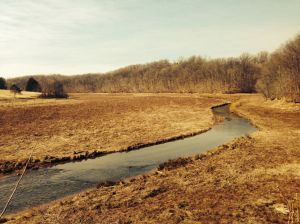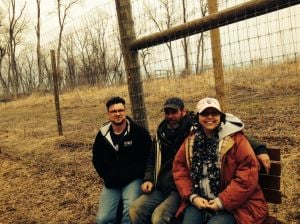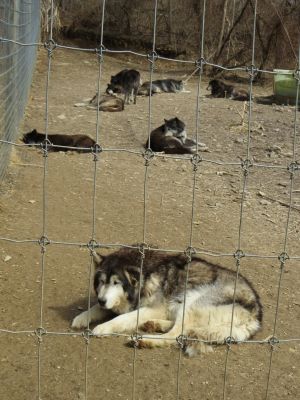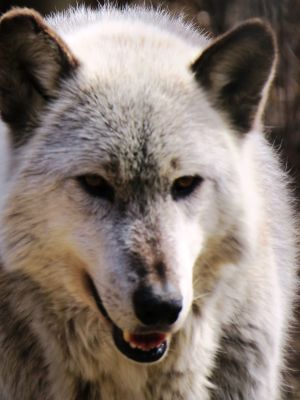Posted: Monday, March 31, 2014
The connection between wolves and scraping the bottom of the temporarily drained Speedwell Forge Lake is not as convoluted as you might think. The lake north of Lititz badly needs 48 years worth of smothering
silt removed from its bottom to become more friendly to fish, anglers
and paddlers. The earth-moving project should begin any day now with big backhoes and dump trucks on the lake bottom. The lake's damaged dam will be repaired, beginning this August, and the lake refilled, possibly by spring 2016.
The 43 wolves currently living at the Wolf Sanctuary of PA, just 1 mile away, need soil for a new 8-acre expansion at the refuge and tourist attraction. The enlargement will enable the sanctuary to provide a humane home to more uprooted wolves and provide more space for wolves to form their socialized packs.
 The sanctuary and Save Speedwell,
a grassroots group that spearheaded and secured a $432,509 state
Growing Greener grant to fund the lake-deepening project, hooked up and
both are delighted. “We wanted to improve the habitat of the lake
and the longevity of the lake would be a benefit,” Milt Lauch of Save
Speedwell says of the project to deepen the lake bottom to a level it
was when the lake came into being in 1966 by damming Hammer Creek. “A lot of people said that it’s not going to do
any good to rebuild the dam if you’re not going to do anything about the
sediment in the lake.” Says Dawn Darlington, president of Wolf Sanctuary
of PA and a longtime supporter of saving Speedwell Forge Lake, “It’s
two nonprofits helping each other.”
The sanctuary and Save Speedwell,
a grassroots group that spearheaded and secured a $432,509 state
Growing Greener grant to fund the lake-deepening project, hooked up and
both are delighted. “We wanted to improve the habitat of the lake
and the longevity of the lake would be a benefit,” Milt Lauch of Save
Speedwell says of the project to deepen the lake bottom to a level it
was when the lake came into being in 1966 by damming Hammer Creek. “A lot of people said that it’s not going to do
any good to rebuild the dam if you’re not going to do anything about the
sediment in the lake.” Says Dawn Darlington, president of Wolf Sanctuary
of PA and a longtime supporter of saving Speedwell Forge Lake, “It’s
two nonprofits helping each other.”
The 106-acre lake was drained in late 2011 after heavy rains from Tropical Storm Lee caused a surge that significantly damaged the 830-foot-long dam and spillway. Its future was uncertain until a united effort by its fans and legislators secured funding for its repair. Work on a new dam is scheduled to start this summer. When the impoundment is filled again, it will be improved in a variety of ways.
Silt washed down by Hammer Creek was filling the lake. Some areas had filled in considerably. “Paddlers were hitting sediment about 2 feet down,” notes Lauch.
By scraping about 5 feet from the bottom in the most-used areas, the lake will aid those in kayaks and canoes. It will keep sediment from flushing into the Chesapeake Bay. And it will provide better habitat for crappie, largemouth bass, bluegill, catfish and carp, and allow them to once again populate all parts of the lake.
When the lake was drained, the Pennsylvania Fish and Boat Commission and volunteers removed some 17,000 fish in October and November 2011. To improve fishing in the heaviest-used part of the lake, the sediment removal will be concentrated in a 1,000-foot-long corridor on the northwestern side of the lake near the picnic pavilions, the bridge across the lake and the PFBC regional office.
 Lancaster County Bassmasters,
a local fishing group, has adopted the lake and is working with PFBC to
establish fish habitat. Rubble from the dam may be used to create
spawning beds.
Lancaster County Bassmasters,
a local fishing group, has adopted the lake and is working with PFBC to
establish fish habitat. Rubble from the dam may be used to create
spawning beds.
Removal of the sediment also will increase the lake’s life expectancy. An estimated 37,000 cubic yards of rich sediment will be removed. That’s about 1,059 truckloads.
That’s a huge pile of dirt. Where should it go?
The sediment was sampled to make sure it didn’t contain high levels of pollutants. The soil got a clean bill of health and was classified as clean fill. Several farmers expressed an interest but additional costs would have been incurred because the dirt would have to be stockpiled, dried and then spread on fields.
The Wolf Sanctuary of PA offered a perfect low-cost solution. The dirt would only have to be hauled 1 mile away and dumped in two places where it will be stockpiled and used as needed. The sanctuary has embarked on a major expansion that will add eight acres of pens to the 30 acres already devoted to the wolves. The addition is being built from a corn field on the 120-acre sanctuary property. Dirt is constantly needed to cover buried fence that keeps the wolves from digging out of their enclosures.
The sanctuary’s services are growing.
The purebred gray wolves and wolf-dog hybrids come from many sources. Some are confiscated by the Pennsylvania Game Commission from private owners who don’t have proper permits. Some are taken from zoos that no longer want them and many are given up by people when the luster of owning a wolf wears off.
Darlington would rather that no wolves be held captive. But even more distasteful to her would be euthanizing the canines because there is no place for them to live out their lives. “The animals that come here — it’s a life home for them,” says Darlington, daughter of sanctuary founder William H. Darlington, who died in 1998.
Many volunteers, donations of food and services, as well as income and purchases from the sanctuary’s gift shop help the sanctuary continue, including the 400 to 600 pounds of food fed to the wolves every week.
The sanctuary has been a nonprofit since 1993. It was opened to public tours in 2005 and adopted a strong educational focus in 2007. Lauch, whose home overlooks the dry lake bed, said many people are eager to have their lake back. “There were a lot of people who came here to fish, to boat and to look at wildlife.”
Gone is a rookery of night herons and a pair of eagles. Confused are migratory waterfowl that continue to show up each spring and fall. “People got married and engaged here,” Lauch says. “One lady said her husband’s ashes were in the lake. A guy threw his engagement ring into the lake and was going to get a metal detector. “State Sen. Michael Brubaker said he learned to fish there. A lot of people talked about learning to swim in the lake.”
source
The 43 wolves currently living at the Wolf Sanctuary of PA, just 1 mile away, need soil for a new 8-acre expansion at the refuge and tourist attraction. The enlargement will enable the sanctuary to provide a humane home to more uprooted wolves and provide more space for wolves to form their socialized packs.
 The sanctuary and Save Speedwell,
a grassroots group that spearheaded and secured a $432,509 state
Growing Greener grant to fund the lake-deepening project, hooked up and
both are delighted. “We wanted to improve the habitat of the lake
and the longevity of the lake would be a benefit,” Milt Lauch of Save
Speedwell says of the project to deepen the lake bottom to a level it
was when the lake came into being in 1966 by damming Hammer Creek. “A lot of people said that it’s not going to do
any good to rebuild the dam if you’re not going to do anything about the
sediment in the lake.” Says Dawn Darlington, president of Wolf Sanctuary
of PA and a longtime supporter of saving Speedwell Forge Lake, “It’s
two nonprofits helping each other.”
The sanctuary and Save Speedwell,
a grassroots group that spearheaded and secured a $432,509 state
Growing Greener grant to fund the lake-deepening project, hooked up and
both are delighted. “We wanted to improve the habitat of the lake
and the longevity of the lake would be a benefit,” Milt Lauch of Save
Speedwell says of the project to deepen the lake bottom to a level it
was when the lake came into being in 1966 by damming Hammer Creek. “A lot of people said that it’s not going to do
any good to rebuild the dam if you’re not going to do anything about the
sediment in the lake.” Says Dawn Darlington, president of Wolf Sanctuary
of PA and a longtime supporter of saving Speedwell Forge Lake, “It’s
two nonprofits helping each other.”The 106-acre lake was drained in late 2011 after heavy rains from Tropical Storm Lee caused a surge that significantly damaged the 830-foot-long dam and spillway. Its future was uncertain until a united effort by its fans and legislators secured funding for its repair. Work on a new dam is scheduled to start this summer. When the impoundment is filled again, it will be improved in a variety of ways.
Silt washed down by Hammer Creek was filling the lake. Some areas had filled in considerably. “Paddlers were hitting sediment about 2 feet down,” notes Lauch.
By scraping about 5 feet from the bottom in the most-used areas, the lake will aid those in kayaks and canoes. It will keep sediment from flushing into the Chesapeake Bay. And it will provide better habitat for crappie, largemouth bass, bluegill, catfish and carp, and allow them to once again populate all parts of the lake.
When the lake was drained, the Pennsylvania Fish and Boat Commission and volunteers removed some 17,000 fish in October and November 2011. To improve fishing in the heaviest-used part of the lake, the sediment removal will be concentrated in a 1,000-foot-long corridor on the northwestern side of the lake near the picnic pavilions, the bridge across the lake and the PFBC regional office.
 Lancaster County Bassmasters,
a local fishing group, has adopted the lake and is working with PFBC to
establish fish habitat. Rubble from the dam may be used to create
spawning beds.
Lancaster County Bassmasters,
a local fishing group, has adopted the lake and is working with PFBC to
establish fish habitat. Rubble from the dam may be used to create
spawning beds.Removal of the sediment also will increase the lake’s life expectancy. An estimated 37,000 cubic yards of rich sediment will be removed. That’s about 1,059 truckloads.
That’s a huge pile of dirt. Where should it go?
The sediment was sampled to make sure it didn’t contain high levels of pollutants. The soil got a clean bill of health and was classified as clean fill. Several farmers expressed an interest but additional costs would have been incurred because the dirt would have to be stockpiled, dried and then spread on fields.
The Wolf Sanctuary of PA offered a perfect low-cost solution. The dirt would only have to be hauled 1 mile away and dumped in two places where it will be stockpiled and used as needed. The sanctuary has embarked on a major expansion that will add eight acres of pens to the 30 acres already devoted to the wolves. The addition is being built from a corn field on the 120-acre sanctuary property. Dirt is constantly needed to cover buried fence that keeps the wolves from digging out of their enclosures.
The sanctuary’s services are growing.
The purebred gray wolves and wolf-dog hybrids come from many sources. Some are confiscated by the Pennsylvania Game Commission from private owners who don’t have proper permits. Some are taken from zoos that no longer want them and many are given up by people when the luster of owning a wolf wears off.
Darlington would rather that no wolves be held captive. But even more distasteful to her would be euthanizing the canines because there is no place for them to live out their lives. “The animals that come here — it’s a life home for them,” says Darlington, daughter of sanctuary founder William H. Darlington, who died in 1998.
Many volunteers, donations of food and services, as well as income and purchases from the sanctuary’s gift shop help the sanctuary continue, including the 400 to 600 pounds of food fed to the wolves every week.
The sanctuary has been a nonprofit since 1993. It was opened to public tours in 2005 and adopted a strong educational focus in 2007. Lauch, whose home overlooks the dry lake bed, said many people are eager to have their lake back. “There were a lot of people who came here to fish, to boat and to look at wildlife.”
Gone is a rookery of night herons and a pair of eagles. Confused are migratory waterfowl that continue to show up each spring and fall. “People got married and engaged here,” Lauch says. “One lady said her husband’s ashes were in the lake. A guy threw his engagement ring into the lake and was going to get a metal detector. “State Sen. Michael Brubaker said he learned to fish there. A lot of people talked about learning to swim in the lake.”
source



No comments:
Post a Comment